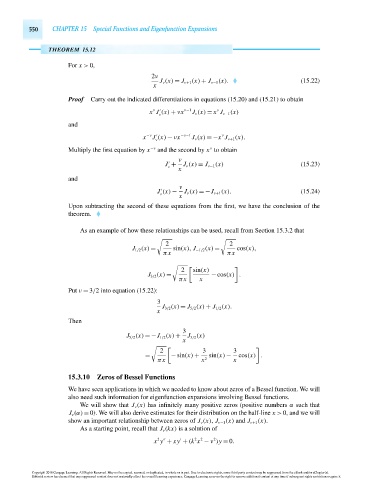Page 570 - Advanced_Engineering_Mathematics o'neil
P. 570
550 CHAPTER 15 Special Functions and Eigenfunction Expansions
THEOREM 15.12
For x > 0,
2ν
J ν (x) = J ν+1 (x) + J ν−1 (x). (15.22)
x
Proof Carry out the indicated differentiations in equations (15.20) and (15.21) to obtain
ν
ν
x J (x) + νx ν−1 J ν (x) = x J ν−1 (x)
ν
and
ν
x −ν J (x) − νx −ν−1 J ν (x) =−x J ν+1 (x).
ν
ν
Multiply the first equation by x −ν and the second by x to obtain
ν
J + J ν (x) = J ν−1 (x) (15.23)
ν
x
and
ν
J (x) − J ν (x) =−J ν+1 (x). (15.24)
ν
x
Upon subtracting the second of these equations from the first, we have the conclusion of the
theorem.
As an example of how these relationships can be used, recall from Section 15.3.2 that
2 2
J 1/2 (x) = sin(x), J −1/2 (x) = cos(x),
πx πx
2 sin(x)
J 3/2 (x) = − cos(x) .
πx x
Put ν = 3/2 into equation (15.22):
3
J 3/2 (x) = J 5/2 (x) + J 1/2 (x).
x
Then
3
J 5/2 (x) =−J 1/2 (x) + J 3/2 (x)
x
2 3 3
= −sin(x) + sin(x) − cos(x) .
πx x 2 x
15.3.10 Zeros of Bessel Functions
We have seen applications in which we needed to know about zeros of a Bessel function. We will
also need such information for eigenfunction expansions involving Bessel functions.
We will show that J ν (x) has infinitely many positive zeros (positive numbers α such that
J ν (α) = 0). We will also derive estimates for their distribution on the half-line x > 0, and we will
show an important relationship between zeros of J ν (x), J ν−1 (x) and J ν+1 (x).
As a starting point, recall that J ν (kx) is a solution of
2
2
2
2
x y + xy + (k x − ν )y = 0.
Copyright 2010 Cengage Learning. All Rights Reserved. May not be copied, scanned, or duplicated, in whole or in part. Due to electronic rights, some third party content may be suppressed from the eBook and/or eChapter(s).
Editorial review has deemed that any suppressed content does not materially affect the overall learning experience. Cengage Learning reserves the right to remove additional content at any time if subsequent rights restrictions require it.
October 14, 2010 15:20 THM/NEIL Page-550 27410_15_ch15_p505-562

